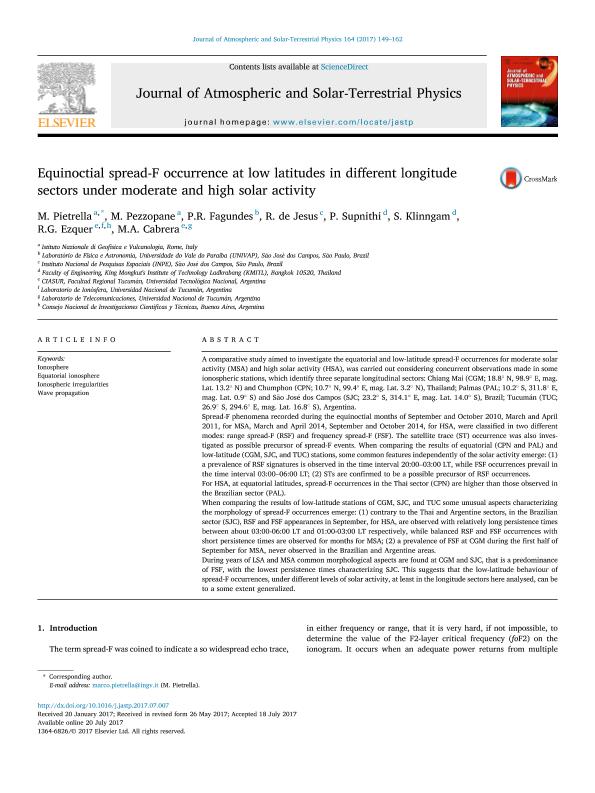Artículo
Equinoctial spread-F occurrence at low latitudes in different longitude sectors under moderate and high solar activity
Pietrella, M.; Pezzopane, M; Fagundes, P. R.; de Jesús, R.; Supnithi, P.; Klinngam, S.; Ezquer, Rodolfo Gerardo ; Cabrera, Miguel Angel
; Cabrera, Miguel Angel
 ; Cabrera, Miguel Angel
; Cabrera, Miguel Angel
Fecha de publicación:
11/2017
Editorial:
Elsevier
Revista:
Journal of Atmospheric and Solar-Terrestrial Physics
ISSN:
1364-6826
Idioma:
Inglés
Tipo de recurso:
Artículo publicado
Clasificación temática:
Resumen
A comparative study aimed to investigate the equatorial and low-latitude spread-F occurrences for moderate solar activity (MSA) and high solar activity (HSA), was carried out considering concurrent observations made in some ionospheric stations, which identify three separate longitudinal sectors: Chiang Mai (CGM; 18.8° N, 98.9° E, mag. Lat. 13.2° N) and Chumphon (CPN; 10.7° N, 99.4° E, mag. Lat. 3.2° N), Thailand; Palmas (PAL; 10.2° S, 311.8° E, mag. Lat. 0.9° S) and São José dos Campos (SJC; 23.2° S, 314.1° E, mag. Lat. 14.0° S), Brazil; Tucumán (TUC; 26.9° S, 294.6° E, mag. Lat. 16.8° S), Argentina. Spread-F phenomena recorded during the equinoctial months of September and October 2010, March and April 2011, for MSA, March and April 2014, September and October 2014, for HSA, were classified in two different modes: range spread-F (RSF) and frequency spread-F (FSF). The satellite trace (ST) occurrence was also investigated as possible precursor of spread-F events. When comparing the results of equatorial (CPN and PAL) and low-latitude (CGM, SJC, and TUC) stations, some common features independently of the solar activity emerge: (1) a prevalence of RSF signatures is observed in the time interval 20:00–03:00 LT, while FSF occurrences prevail in the time interval 03:00–06:00 LT; (2) STs are confirmed to be a possible precursor of RSF occurrences. For HSA, at equatorial latitudes, spread-F occurrences in the Thai sector (CPN) are higher than those observed in the Brazilian sector (PAL). When comparing the results of low-latitude stations of CGM, SJC, and TUC some unusual aspects characterizing the morphology of spread-F occurrences emerge: (1) contrary to the Thai and Argentine sectors, in the Brazilian sector (SJC), RSF and FSF appearances in September, for HSA, are observed with relatively long persistence times between about 03:00-06:00 LT and 01:00-03:00 LT respectively, while balanced RSF and FSF occurrences with short persistence times are observed for months for MSA; (2) a prevalence of FSF at CGM during the first half of September for MSA, never observed in the Brazilian and Argentine areas. During years of LSA and MSA common morphological aspects are found at CGM and SJC, that is a predominance of FSF, with the lowest persistence times characterizing SJC. This suggests that the low-latitude behaviour of spread-F occurrences, under different levels of solar activity, at least in the longitude sectors here analysed, can be to a some extent generalized.
Archivos asociados
Licencia
Identificadores
Colecciones
Articulos(CCT - NOA SUR)
Articulos de CTRO.CIENTIFICO TECNOL.CONICET - NOA SUR
Articulos de CTRO.CIENTIFICO TECNOL.CONICET - NOA SUR
Citación
Pietrella, M.; Pezzopane, M; Fagundes, P. R.; de Jesús, R.; Supnithi, P.; et al.; Equinoctial spread-F occurrence at low latitudes in different longitude sectors under moderate and high solar activity; Elsevier; Journal of Atmospheric and Solar-Terrestrial Physics; 164; 11-2017; 149-162
Compartir
Altmétricas



